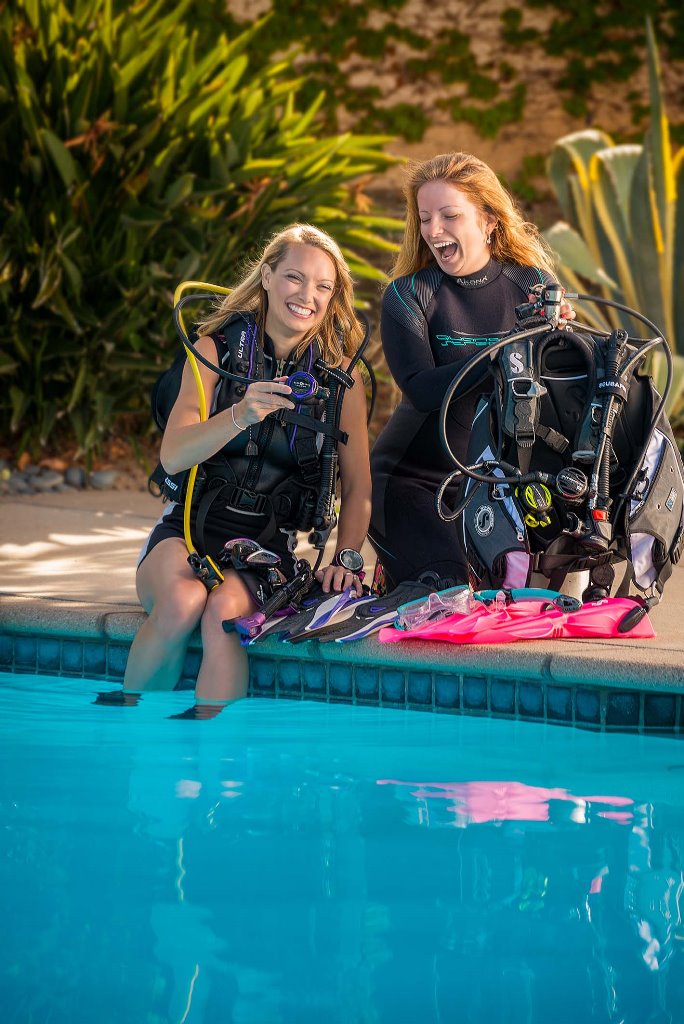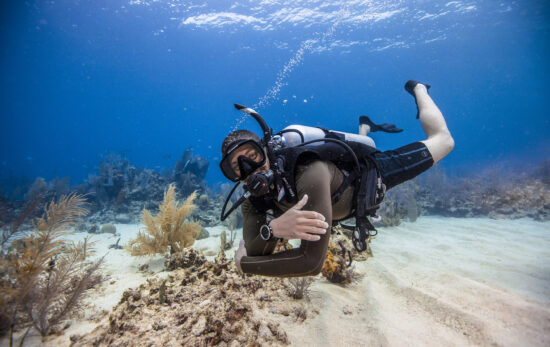Both scuba diving and snorkeling are excellent activities for anyone who enjoys seeing marine life in its natural environment. The main difference between snorkeling and scuba diving is the air supply. Breathing from a scuba tank allows you to stay underwater longer and dive deeper, but it requires additional training.
If you enjoy snorkeling and are curious about scuba diving, read on! Even if you don’t like snorkeling, you should still keep reading. You don’t have to like one to enjoy the other.
Difference #1: Air Supply
Scuba divers carry tanks on their backs (or alongside their bodies) and draw air from the tank via a mouthpiece attached to a sturdy hose. Snorkelers, by contrast, breathe air from the surface through a tube.
In case you weren’t already aware, the word ‘scuba’ is actually an acronym. SCUBA stands for self-contained underwater breathing apparatus.
Difference #2: Equipment
Scuba divers wear a lot more equipment than snorkelers. The breathing apparatus described above is called a regulator. Fun fact: the Star Wars production team used a scuba regulator to create Darth Vader’s creepy, ominous breathing.
Divers also need a buoyancy control device or BCD. The most common type of BCD is a vest that inflates, but there are other ways to adjust your buoyancy. Divers who wear dry suits may inflate and deflate their dry suit for buoyancy control.
What’s all this buoyancy stuff about? Put simply, divers don’t want to be too heavy or too floaty. Part of learning to scuba dive is finding the right balance between the weight you carry and how much air is in your buoyancy control device.
Scuba divers also carry small, submersible computers and/or gauges to keep track of how deep they are and how much air they have left. The computers/gauges can be attached to the grouping of hoses known as the octopus, or worn like a wristwatch.

Both scuba divers and snorkelers wear a mask, snorkel and fins. Most high-quality snorkel masks can be used for scuba diving, but the majority of snorkel fins are too flimsy. Scuba fins are designed to move divers and their equipment through the water with minimal effort. If you have a snorkel set and want to learn to scuba dive, bring your snorkel mask and fins to the dive shop before your first in-water session.
In addition to snorkel gear, both divers and snorkelers typically wear some form of exposure protection. Divers typically wear a wetsuit (either a full suit or shorty); but in tropical water, some may only wear a dive skin, rashguard and trunks, or just a swimsuit.
Learn more about the equipment you need to scuba dive.
Difference #3: Maximum Depth
The average snorkeler can swim down 3-4 meters (12-15 feet). Experienced snorkelers may reach 7 meters (25 feet). By comparison, experienced divers can explore down to 40 meters (130 feet). Don’t worry, scuba students aren’t expected (or allowed) to dive that deep. During your PADI® scuba certification course, it’s unlikely your dives will be deeper than 12meters (40 feet).

Difference #4: What You Get to See
One of the major advantages of scuba diving is how much more of the underwater world you get to see. Unlike snorkeling, you’re not limited by how long you can hold your breath. You can explore deeper and stay longer, which means you can:
- Wait for an octopus to come out of its hole
- Watch color-changing cuttlefish put on a show
- Experience a manta ray ballet
- See a turtle get its shell cleaned
As a diver, you can also explore shipwrecks, ride underwater scooters and experience the underwater world at night.
Also, because there are fewer divers compared to snorkelers, you’re less likely to bash skulls with someone or get finned in the face while trying to see something interesting.
Difference #5: Training Time and Cost to Get Started
If you already know how to swim, learning to snorkel is fairly easy. People of all ages can master basic snorkeling skills in 30 minutes or less.
Learning to scuba dive requires at least three (typically four) days of in-water training. There is also a home study component that covers scuba diving terminology, explains buoyancy and other scuba diving essentials. The vast majority of dive students use PADI’s interactive online training program PADI eLearning®. The home study and in-water training require a minimum of four days; upon completion, you receive an Open Water Diver certification (which is good for life).
A scuba certification costs about the same as:
- a full day of surfing lessons
- a weekend of rock climbing, kayaking or fly-fishing lessons
- a weekend of kayaking lessons
- about three hours of private golf lessons
- about three hours of private water skiing lessons
- one amazing night out at the pub!
Learn more about earning a scuba certification, or try a free intro to Open Water course (no credit card required). If you’re unsure whether you want to enroll in a multi-day scuba diving course, try a half-day Discover Scuba Diving® Experience first.
Difference #6: Spontaneity
Snorkeling takes very little planning or preparation. All you need to do is throw your snorkel set in a bag with a rashguard or some reef safe sunscreen and you’re ready to go. You can pop in and out of the water as often as you like.
Scuba diving takes a bit more preparation because of the equipment required. You also can’t fly in an airplane within 18-24 hours of scuba diving and surface intervals are required between dives. Lastly, while people of all ages and abilities enjoy scuba diving, people with certain medical conditions may need a doctor’s approval to dive.
Ready to Dive In?
- Read more about what you need to know about going from snorkeler to scuba diver.
- Start your Open Water Diver training online – FREE!
- Try scuba diving before you commit to a class, sign up for a half-day Discover Scuba Diving® Experience.
Have questions? Review these scuba diving FAQs or contact a friendly scuba diving expert at a PADI Dive Center or Resort.
Freediving
If you enjoy snorkeling and love the idea of extending your time underwater, but don’t love the idea of wearing scuba gear – freediving might be for you. Read about the Difference Between Freediving and Snorkeling, or sign up for a PADI Freediver™ or Basic Freediver course.





